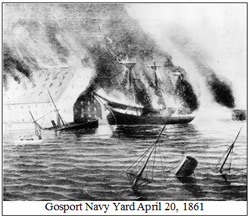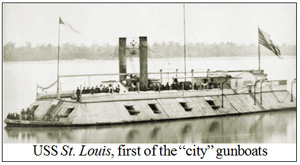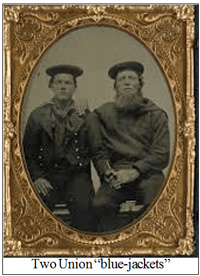
Volume
29, No. 2 – February 2016
Volume 29, No. 2
Editor: Stephen L. Seftenberg
Website:
www.CivilWarRoundTablePalmBeach.org
The President’s Message
Dues Are Due! Thank you to everyone who has already paid. For the
most efficient operation of the Round Table, dues must be paid in a
timely matter. The January election results were President: Gerridine
LaRovere, Vice-President: George Nimberg, Secretary: Stephen Seftenberg,
Treasurer: Robert Krasner, Directors: Morris Ball, Monroe Ackerman and
Craig Freis.
Every member is asked to bring a refreshment once a year. The sign up
sheet will be passed around at the monthly meetings.
February 10, 2016 Meeting
William T. Sherman once stated that the key to military operations is
grub and mules. After a long tedious march Civil War soldiers
hoped to chow down on a hardy meal. Instead they were served “blue
beef,” “sheet-iron” crackers and a liquid erroneously called coffee.
Learn how soldiers and civilians ingeniously endured the struggle for
survival. Enjoy a mouth-watering taste of vinegar pie. It’s really
delicious.
January 13, 2016 Meeting
Bill Hines: “The Union Navy in the Civil War”
Bill Hines comes to us after 25 years service in the United States Navy
and the National Park System.
In the 1840s naval construction was revolutionized, but the U. S. Navy
did not pick up on it. As was often said of our navy, “200 years
of tradition unmarred by progress.” The two basic components of
the revolution were the steam engine and the propellor. A glimmer
of progress went dark when the experimental gun on the deck of the
navy’s US Navy's first screw-propelled steam-frigate USS Princeton
exploded, killing the Secretaries of State and Navy, and the old guard
unfairly blamed John Ericcson, who helped design the steam-frigate and
who is now regarded as one of the most influential mechanical engineers
ever. Faced with a “warship gap,” in the 1850s, Congress
authorized the money for two ironclad steamships. Red tape delayed
design and construction. By 1860, our navy was nearly mothballed.
A further setback was that most of the high ranking Naval officers were
Southerners and over 200 resigned and went South when secession began.
The new president, Abraham Lincoln had to tread carefully as he
considered how to curtail imports and exports to and from the seceding
states under international law. He labeled their residents as
“rebels” and not a “nation.” After a brief plan of a “boycott” to
combat a rebel “insurrection,” he signed papers invoking Gen. Scott’s
“Anaconda Plan” and establishing a blockade. The North did not try
to shut the ports, which would in sense have recognized the South as a
separate nation. In any event it was doubtful that at this stage of the
war the North could have taken any of the Southern ports.
.
Gideon Welles (7/1/1802-2/11/1872) was a good Secretary of the Navy.
Following secession, Welles sent his brother-in-law North to buy up
every sloop, small ship, etc. available, to flesh out his navy while new
ships were being built. Despite initial misgivings about the
Anaconda Plan, his efforts to rebuild the Navy and implement the
blockade proved extraordinarily effective. From 76 ships and 7,600
sailors in 1861 (and despite significant manpower losses to the
Confederate Navy after secession), a massive ship construction campaign
embracing technological innovations from civil engineer James Buchanan
Eads and naval engineers like Benjamin F. Isherwood and John Ericsson,
allowed the Navy to expand almost tenfold by 1865. The Naval
portion of the Anaconda Plan eventually weakened the Confederacy's
ability to finance the war by limiting the cotton trade, and while never
completely effective in sealing off all 3,500 miles of Southern
coastline, it was a major contribution to Northern victory.
Lincoln nicknamed Welles his "Neptune." Welles was also
instrumental in the Navy's creation of the Medal of Honor.
Jefferson Davis had to start the Confederate Navy from scratch.
Matching the North’s manufacturing advantage was impossible, so he
resorted to issuing Letters of Marque authorizing the seizure or sinking
of Northern merchant ships. When one Northern ship was captured
and taken to Mobile, one brave black cook killed the guards and sailed
his ship to New York! When Lincoln said he would hang captured
Southern privateers as pirates, Davis countered by threatening to hang
one Northern prisoner for each privateer hung. Lincoln backed off.
 Davis
had one initial advantage; Southern forces took over the Gosport
Shipyard (built on 16 acres on Hampton Roads in 1767 and purchased by
the federal government in 1801 for $12,000). On the eve of war,
the Northern commander tried to burn the shipyard but was only partially
successful before the South took the yard by ruse. The capture of
the shipyard allowed a tremendous amount of war material to fall into
Confederate hands, including 1,195 heavy guns used elsewhere, including
the Mississippi. Davis
had one initial advantage; Southern forces took over the Gosport
Shipyard (built on 16 acres on Hampton Roads in 1767 and purchased by
the federal government in 1801 for $12,000). On the eve of war,
the Northern commander tried to burn the shipyard but was only partially
successful before the South took the yard by ruse. The capture of
the shipyard allowed a tremendous amount of war material to fall into
Confederate hands, including 1,195 heavy guns used elsewhere, including
the Mississippi.
In early 1862, the ironclad warship CSS Virginia was rebuilt
using the burned-out hulk of USS Merrimack. Virginia
sank USS Cumberland, USS Congress, and engaged the
Union ironclad USS Monitor. Monitor was the odd
result of the contract authorizing the US Navy to build three
“ironclads.” Plans to build ironclad sailing ships were delayed
and Welles ordered John Ericcson’s design of a “cheese box on a raft”
built over the objections of three admirals, who agreed it would never
float after taking the design to Lincoln, who loved technology.
Virginia was really underarmored (2 1/4 inches vs.
Monitor’s 8 inches!), but its design was clever (slanted sides
greased with tallow so the solid balls would bounce off).
Monitor had some serious design problems. It’s “freeboard”
was only 6 inches, so it could not go outside the 12-mile limit or risk
being swamped (which eventually happened in a storm). The
Confederates even thought about capturing Monitor. At a
later point, Welles vetoed a plan by the US Navy commander to sail
Monitor up to Richmond lest it be captured.
Bill then told us he had been there when Monitor’s upside-down
turret (which had been located in 1973) was raised by the US Navy’s
Salvage Team in two months and taken to the Mariners' Museum in Newport
News, Virginia. Many skeletons were found but not the pet cat!
The South was fortunate that Stephen R. Mallory (1812-11/9/1873) was its
Secretary of the Navy. One of his better decisions was to
concentrate on ironclad “rams” to open up the Southern ports and its 185
rivers, both for blockade runners and to combat Union forces along and
West of the Mississippi. He also fostered the use of “torpedos”
(really mines) and submarines (he noted that CSS HL Hunley was
not the only submarine used in the war (USS Alligator was to be
used in an attack on Charleston Harbor but sank off Cape Hatteras in bad
weather).
Mallory also unleashed naval raiders built in England. The most
famous raider, CSS Florida built a squadron of captured and
converted ships that altogether took sixty prizes. Confederate
sailors circumnavigated the globe and some landed in ports as far-flung
as Singapore, Australia, South Africa, and Brazil. Although the
Northern merchant fleet began the war with roughly 5,000 ships, many
were sunk and many more were sold to foreigners by frightened owners, or
preregistered in England or Russia, reducing the total to less than
2,500 by the end of the war. Lloyds of London was almost
bankrupted by claims. This feat was accomplished by less than
twenty Confederate ships.
Bill reminded us that the senior officers of the US Navy in 1861 were
“lifers” who had been serving since the War of 1812, and were a “dead
weight” on novel strategy and designs. Stars such as Farragut only
made captain after 50 years! The seniority rules blocked the
promotion by merit and after the war the Navy reverted to the old style.
Fortunately there were two US navies – Regular and Volunteer and the
latter brought new blood into the system. Farragut was no
technological innovator, initially disliking ironclads as “abominable
machines,” but he realized they were useful in taking New Orleans.
The US Navy mostly ignored the US Army and fought its own war. In
April 1862, Farragut led an attack up the Mississippi River, aiming to
get his ships past Forts Jackson and St. Philip and in a position to
bombard the city with impunity. After twelve days of combat, Fort
Jackson was in shambles and the Union fleet had its cannons trained on
New Orleans. With no organized infantry defense, New Orleans fell
to an expeditionary force of 5,000 men on May 1, 1862. Its capture
catapulted Farragut to fame, including a promotion to become the
nation’s first admiral, and dealt a severe blow to the Confederacy.
Farragut then wanted to take Vicksburg without the Army’s help, but was
denied by the city’s guns. Exception to this “go it alone”
philosophy include Gen. Benjamin Burnside’s successful amphibious
campaign against Roanoke Island, February 7-8, 1862) and Farragut’s
eventual capture of Mobile in August 1864 in a successful Army-Navy
plan.
 The
second prong of the Anaconda plan called for capturing Southern strong
points up and down the Mississippi River, effectively cutting the
Confederate territory in two while also robbing the South of its main
artery of transport. A new force of gunboats and river ironclads,
together with regular army units, would take, or at least lay siege to,
the Confederate forts and cities along the Mississippi. In the
early days of the war, these boats were built and crewed by the U.S.
Army, with the naval officers commanding them being the only direct
connection to the U.S. Navy. By the autumn of 1862, the boats and
their mission were transferred to the Department of the Navy.
Because of the river's murky brown water, the ships that participated in
these Mississippi campaigns were quickly referred to as the brown-water
navy, as opposed to the regular US Navy (which was henceforth referred
to as the deep-water or blue-water navy). The
second prong of the Anaconda plan called for capturing Southern strong
points up and down the Mississippi River, effectively cutting the
Confederate territory in two while also robbing the South of its main
artery of transport. A new force of gunboats and river ironclads,
together with regular army units, would take, or at least lay siege to,
the Confederate forts and cities along the Mississippi. In the
early days of the war, these boats were built and crewed by the U.S.
Army, with the naval officers commanding them being the only direct
connection to the U.S. Navy. By the autumn of 1862, the boats and
their mission were transferred to the Department of the Navy.
Because of the river's murky brown water, the ships that participated in
these Mississippi campaigns were quickly referred to as the brown-water
navy, as opposed to the regular US Navy (which was henceforth referred
to as the deep-water or blue-water navy).
Ulysses S. Grant claimed that he could not have taken Vicksburg,
Mississippi, without the navy. Successful river operations
demanded high-tech ironclad and steam powered fleets and led to the
development of naval strategies that are still used by the American
military. In terms of the number of sailors involved and the miles
of river contested, the scale of the Civil War on “brown water” exceeds
all other American wars, with Vietnam second.
After Vicksburg was captured, Farragut and Grant wanted to capture
Mobile and mop up the balance of the South’s forces West of Virginia, but Halleck sent him to
Texas instead to shut down trade between the Confederacy and the French
who controlled Mexico. The so-called “Red River Campaign”
(March-May 1864) was a nearly-total failure due to the incompetence of
Nathenial P. Banks, one of Lincoln’s “political generals.”
balance of the South’s forces West of Virginia, but Halleck sent him to
Texas instead to shut down trade between the Confederacy and the French
who controlled Mexico. The so-called “Red River Campaign”
(March-May 1864) was a nearly-total failure due to the incompetence of
Nathenial P. Banks, one of Lincoln’s “political generals.”
What about the sailors in the Civil War? The average age of a
“blue-jacket” was 26, mostly urban, 92% from the Northeastern states and
recruited from the merchant marine but the promise of prize money (salt,
slaves, and cotton). One problem facing the Union fight against
blockade runners was their practice, if trapped, of jettisoning their
cotton. The Union ships would stop to save the cotton, worth $200/bale!
Beginning in 1863, the US Navy began to recruit freed slaves, putting
their families in safe US naval bases. This lasted until World War I.
The US Navy was not segregated until after the Civil War and remained
segregated until the Truman Administration after World War II.
Bill now turned to his Park Service experiences related to the Civil
War. He specialized in archaelogy in Yorktown, Fredericksburg and
The Wilderness. There was scant effort in this speciality until
FDR put people to work in the 30’s. The Park Service relied upon
aerial photographs to locate specific battle sites, but the park “battle
fields” are substantially smaller than they were in the war.
Originally, spent shells, etc., were plentiful but eventually just about
everything was dug up. A serious problem exists with the effort:
originally admission to the park system was intended to cover
maintenance. But Congress has been seriously underfunding the park
system, with predictable results.
Bill received a number of questions and a warm round of applause for his
interesting talk.
Last changed: 02/03/16
Home
About News
Newsletters
Calendar
Memories
Links Join
|

